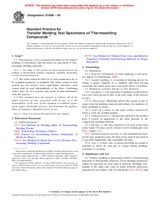Potřebujeme váš souhlas k využití jednotlivých dat, aby se vám mimo jiné mohly ukazovat informace týkající se vašich zájmů. Souhlas udělíte kliknutím na tlačítko „OK“.
ASTM D1896-09
Standard Practice for Transfer Molding Test Specimens of Thermosetting Compounds
Automaticky přeložený název:
Standardní praxe pro přetlačování zkušebních vzorků termosetických sloučenin
NORMA vydána dne 1.12.2009
Informace o normě:
Označení normy: ASTM D1896-09
Poznámka: NEPLATNÁ
Datum vydání normy: 1.12.2009
Kód zboží: NS-18695
Počet stran: 4
Přibližná hmotnost: 12 g (0.03 liber)
Země: Americká technická norma
Kategorie: Technické normy ASTM
Anotace textu normy ASTM D1896-09 :
Keywords:
test specimens, thermosetting compounds, transfer-molding, Molding/extrusion compounds/materials, Thermosetting plastics, ICS Number Code 83.140.99 (Other rubber and plastic products)
Doplňující informace
| Significance and Use | ||||||||||
|
Transfer molding is particularly suited to thermosetting materials of intermediate plasticity. Fixed molding parameters cannot be specified for each type of material. Molding compounds of the same type come in many different plasticities measured in accordance with Test Methods D731, D3123, and D3795. Consequently, for a given material type, the molding parameters required to produce satisfactory test specimens will often vary dependent on the plasticity of the specific material grade. The mold shown in this practice provides for a set of five specimens. However, if only certain specimens are desired, the other cavities can be blocked by inserting gate blanks. Typically, breathing of the mold is not required to release trapped volatile matter as the gas is free to flow from the vent end of the mold. This is a particular advantage for heat-resistant compounds and reduces the tendency for molded specimens to blister at high exposure temperatures. Flow and knit lines in a molded piece are often sites of mechanical or electrical weakness and can be found in some degree of severity throughout the molded piece. The semisolid molding compound passing through the gate is subject to non-Newtonian flow and, consequently, wrinkles and folds as it travels down the mold cavity. Fibers and other reinforcements in the molding compound align with the flow pattern and, consequently, can orient perpendicular to the axis of the bar at the center and parallel at the surface of the bar. Mold temperature, thermal conductivity and plasticity of the molding compound, degree of preheat, and plunger pressure are parameters that influence the time to fill the mold cavities and the formation of knit lines. Note 3—If the temperature of the mold is held constant and the plunger pressure varied for a designated thermosetting molding compound, two extreme characteristic conditions can be obtained. If the pressure is low, then the vent end of the cavity will not fully fill, and weld lines will form by incomplete knitting of the material. If the pressure is too high, the mold cavity will fill fast, the outside of the specimen will case harden while the pressure is still forcing material out the vent, and a ball-and-socket grain structure will be obtained. A ball-and-socket structure is an indication of the molding condition, and lower test data will result. Thermosetting compounds containing long-fiber fillers such as glass roving, chopped cloth, or shavings can be used but are not recommended for transfer molding. These filler materials tend to break, tear, or ball in passing through the gates of the mold, thereby not optimizing their potential strength. The Izod impact strength of transfer molded specimens of molding compounds containing short fibers will generally be lower than the values obtained using compression-molding methods. Quite often the impact strength will vary along the axis of the bar due to molding parameters, flow pattern, and fiber orientation. The flexural and tensile strength of transfer molded specimens of molding compounds containing short fibers will generally be higher than the values obtained using compression-molding methods. Flexural tests are particularly sensitive to transfer molding due to the thin resin skin formed at the surface of the bar during the final filling of the cavity and pressure buildup. |
||||||||||
| 1. Scope | ||||||||||
|
1.1 This practice covers a general procedure for the transfer molding of mechanical and electrical test specimens of thermosetting molding materials. Note 1—The utility of this practice has been demonstrated for the molding of thermosetting molding compounds exhibiting intermediate viscosity non-Newtonian flow. 1.2 The values stated in either SI or inch-pound units are to be regarded separately as standard. The values stated in each system are not always exact equivalents; therefore, each system shall be used independently of the other. Combining values from the two systems may result in nonconformance with this practice. 1.3 This standard does not purport to address all of the safety concerns, if any, associated with its use. It is the responsibility of the user of this standard to establish appropriate safety and health practices and determine the applicability of regulatory limitations prior to use. Note 2—There is no known ISO equivalent to this standard. |
||||||||||
| 2. Referenced Documents | ||||||||||
|
Doporučujeme:
Aktualizace zákonů
Chcete mít jistotu o platnosti užívaných předpisů?
Nabízíme Vám řešení, abyste mohli používat stále platné (aktuální) legislativní předpisy.
Chcete vědět více informací? Podívejte se na tuto stránku.




 Cookies
Cookies
